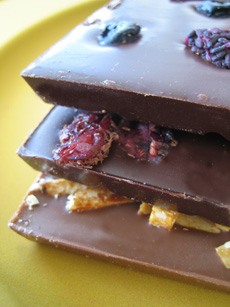 
Artisanal bars from Michael Mischer Chocolates of Oakland, California. Photo by Melody Lan | THE NIBBLE.
|
KAREN HOCHMAN’s first word was not cacahuatl...but as her mother will attest, it was pretty close.
|
|
May 2006
Revised January 2009
|
 |
From Pod to Palate: The Birth Of The Bar
Page 10: Making The Chocolate ~ Packaging The Chocolate
This is Page 10 of a 10-page article on chocolate production. Click on the black links below to visit other pages.
Section 2: Making The Chocolate
15. Packaging The Chocolate
The finished chocolates solidify in a cooling tunnel. In a large operation, a conveyor belt transports the chocolates to the packing machines or packing lines; the entire manufacturing process occurs without a human hand touching the chocolates. In an artisanal chocolate shop, everything is touched by the chocolatier; bars are wrapped with small mechanical wrapping machines; filled chocolates are hand-placed onto trays or into boxed assortments.
Now that you know all of the work that goes into making your chocolate bar or box of chocolates, take good are of it. Think back to Step 12: tempering—chocolate is very sensitive to temperature extremes.
If you’re not going to eat the chocolate within a few days, it should be stored at a temperature between 54°F and 65°F with a relative humidity between 55% and 60%. The ideal place that meets these requirements is a wine refrigerator! Chocolate melts at about 98ºF, which is body temperature and why chocolate simply “melts in your mouth.” It’s also why one shouldn’t keep chocolate in the sunlight, in a hot room, near a stove et al. With overnight shipping and gel packs, it’s easy (if not inexpensive) to ship chocolate during the summer months. We order it all the time and it arrives in pristine condition (as does ice cream!).
Dark chocolate bars can be kept for two years or more if stored properly: well wrapped in foil in a cool, dark, dry place. Milk and white chocolate have a more limited storage time, but will stay fresh for a year or more under these conditions. Filled chocolates, chocolates with nuts and other additives have less of a shelf life because the additives will break down or go rancid. Commercial companies will use preservatives to extend the shelf-life, but most fine chocolates are made preservative-free. A box of fine filled chocolates or truffles should be consumed within two weeks, the sooner the better. The fine fillings, creams, and purees with which they are made deteriorate quickly: to enjoy them they should be eaten soon after they are made. If you have a question about the shelf-life, call the chocolatier.
And enjoy all of those wonderful chocolates...in moderation.
Go To The Article Index Above
More Of Our Favorite Bars:
Valrhona Grand Cru Cacao
Valrhona is considered by many chefs and gourmands around the world to produce the finest chocolate. While we’re too impartial to think that there’s any one best, we will affirm Valrhona is up there in the pantheon. An industry innovator, Valrhona was the first to emulate the wine industry and produce single origin cacao—bars where all the beans came from one specific region. These “Grand Cru” bars are among the best you will taste, and you owe it to yourself to try these three. Even people who don’t ordinarily like milk chocolate will find Jivara to be eye-opening. A fourth Grand Cru, Guanaja, is a 70% cacao Criollo and Trinitario mix from the island of Guanaja off the coast of Honduras. It’s an intense bittersweet chocolate, long on the palate.

|




